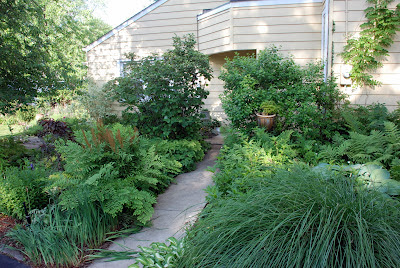Black was the forest: thick with beech it stood,
Horrid with fern, and intricate with thorn;
Few paths of human feet or tracks of beasts, were worn.
Virgil Aeneid Book IX (translation: John Dryden)
FERN FOSSILS
In the Herbarium there is a box that contains some of my fern and leaf fossils. Most were purchased at the annual Gem and Mineralogical Fair, a couple were gifts and a few very special ones were found on a hunt with Carl Mehling and Fiona Brady at one of the preeminent fossil sites - Mazon Creek in Illinois.
SARGENT-WELCH FERNS IN CAST RESIN
This vintage teaching aid was given to me by Ron Povlich. The company that produced it has been in business for over 150 years selling scientific equipment to schools. It is more amusing than beautiful but has a real charm in its old fashioned and sort of innocent presentation.
PEWABIC TILE
One of Detroit's treasures is Pewabic Pottery which was founded in 1903 by Mary Chase Perry Stratton. It has survived through dedicated, hard work and despite the problems of its somewhat difficult location in Detroit. It continues to produce tiles, pottery and artifacts for buildings with its Arts and Crafts ethic of production. Now privately operated, Pewabic Pottery offers classes, mounts shows in their gallery space and maintains a museum that exhibits examples of early work produced there. The fern tile in my collection was purchased in their shop and given to me as a present by our son Barrett.
TISHLERS' HOLIDAY CARD
My cousin Carol's husband Lee was a preparator for the Milwaukee Public Museum. He was a man so very filled with talent, energy and interests that it was hard for him to be doing one thing while knowing he was missing something interesting happening elsewhere. He designed holiday cards every year and produced them with the help of his wife. This one was really labor intensive and certainly worth the effort. Each card had a flattened, dried fern that fit the dimensions of the hand cut and folded paper with its perfectly cut parchment liner. The ferns were spattered with a bit of "snow" and a hand written poem appeared on the back in white ink.

























